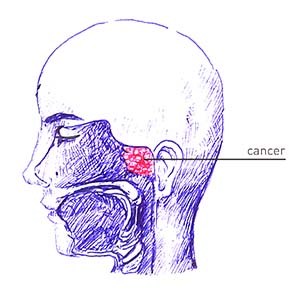The Reality of Nasopharyngeal Cancer
Nasopharyngeal cancer is a type of head and neck cancer where malignant cancer cells form in the tissues of the nasopharynx. The nasopharynx is the upper part of the pharynx (throat) behind the nose.

REALITY CHECK
Nasopharyngeal cancer (NPC) is a common cancer among Malaysians and highly affects Malaysian men. In comparison to the rest of the world, the Malaysian Chinese male has the second highest incidence; the local Chinese women have the highest incidence in the world. In East Malaysia, the Bidayuhs and the Orang Ulus have the highest incidence of NPC.
Common Types of Nasopharyngeal Cancer
SQUAMOUS CELL CANCERS
There are several types of cancer that begin in the tissue that makes up the nasopharynx. However, among the more common nasopharyngeal cancers are squamous cell carcinomas. It is a type of cancer that develops in the squamous cell, which are the flat, skin-like cells that line the inside of your mouth, nose larynx, and throat.
There are 3 main types of squamous cell cancers:
- Keratinising squamous cell carcinoma (type 1)
- Non-keratinising squamous cell carcinoma (type 2)
- Undifferentiated carcinomas (type 3)
A keratinising cancer has keratin in the cancer cells, which is the protein that forms your hair and nails.
Staging and Grading
Once you have been diagnosed positive for cancer after a biopsy test, the condition will be given a stage and grade. This vital information will help you and your healthcare team to choose the best treatment for you. The cancer stage will describe the size of the tumour and how far it has spread.
There are 4 stages for nasopharyngeal cancer:
Stage 1
- The cancer begins in the nasopharynx and may have spread into the nasal cavity or oropharynx. The cancer has not spread to nearby tissues, lymph nodes or other organs
Stage 2
- The cancer may have spread into the oropharynx or even the nasal cavity. It is also found in the lymph nodes on any side of the neck or behind the throat
- The cancer has reached the parts next to the nasopharynx. It might have begun from the lymph nodes on one side of the neck or behind the throat
Stage 3
- The cancer has spread to nearby bones and air cavities (sinuses). It might have also reached lymph nodes on one or both sides of the neck, or behind the throat, but not anywhere else
- The cancer may have begun in the oropharynx, nasal cavity or surrounding area (parapharyngeal space) and has spread into the lymph nodes on both sides of the neck
Stage 4
- The cancer is advanced and is broken into 3 groups:
- 4A means the cancer has grown within the skull. It might be in the cranial (skull) nerves, eye or nearby tissues, or the lower part of the throat. There might be cancer cells in the lymph nodes on one or both sides of the neck. These nodes are smaller than 6cm and above the collarbone area. The cancer has not spread anywhere else
- 4B means the cancer may have reached into nearby tissues or bones. It has spread to at least one lymph node that is bigger than 6cm across, or a lymph node in the collarbone area, or both. The cancer has not spread anywhere else
- 4C means the cancer has spread to other parts of the body, such as the lungs
There are 3 grades of nasopharyngeal cancer:
Grade 1 – It is low grade, and the cancer cells look very much like normal nasopharyngeal cells.
Grade 2 – It is an intermediate grade, and the cancer cells look slightly like normal nasopharyngeal cells.
Grade 3 – Moderate grade with more abnormal appearing nasopharyngeal cells.
WARNING SIGNS
- Hearing loss, ringing in the ear, or feeling of fullness in the ear (especially on one side only)
- Ear infections that keep coming back
- Nasal blockage or stuffiness
- Nosebleeds
- Headache
- Facial pain or numbness
- Trouble opening the mouth
- Blurred or double vision
AM I AT RISK?
Yes, even more so with these factors:
- Tobacco and alcohol abuse
- A certain kind of diet; salt-cured fish and meal
- Infection with the Epstein-Barr virus (EBV)
THERE ARE RISK FACTORS THAT CAN'T BE CHANGED:
- Gender; it is found twice as often in males as it is in females
- Ethnicity; more common in Southeast China and Hong Kong
- Genetic factors
- Family history
WHAT CAN I DO?
Beat the cancer. Cut your risk by taking these steps:
- Stop the use of tobacco products
- Stop or limit alcohol intake
- Have a healthy diet
- Schedule for screening
Nasopharngeal Cancer Myths Vs Facts
Myth |
Fact |
| NPC is only linked to certain parts of the world, mainly Southeast China. | NPC is only linked to certain parts of the world, mainly Southeast China. |
| Blocked nose or neck swelling is a common side effect for flu or fever. There is no need to check for NPC. | It is important to be aware of your nasopharyngeal health, especially if the flu-like symptoms are on-going. Ignorance often causes late diagnosis and delayed treatment. Early screening increases the chances of curing the disease. |






